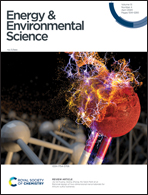Crosslinked fluoropolymers exhibiting superior high-temperature energy density and charge–discharge efficiency†
Abstract
The electrification of transport requires dielectric materials capable of operating efficiently at high temperatures to meet the increasing demand of electrical energy storage at extreme conditions. Current high-temperature dielectric polymers rely on the incorporation of wide bandgap inorganic fillers to restrain electrical conduction and achieve high efficiencies at elevated temperatures. Here, we report a new class of all-polymer based high-temperature dielectric materials prepared from crosslinking of melt-processable fluoropolymers. The crosslinked polymers exhibit larger discharged energy densities and greater charge–discharge efficiencies along with excellent breakdown strength and cyclic stability at elevated temperatures when compared to the current dielectric polymers. The origins of the marked improvement in the high-temperature capacitive performance are traced to efficient charge-trapping by a range of the molecular trapping centers resulting from the crosslinked structures. In addition, the implementation of melt-extrudable polymers would enable scalable processing that is compatible with the current fabrication techniques used for polymer dielectrics, which is in sharp contrast to the dielectric polymer composites with inorganic fillers.



 Please wait while we load your content...
Please wait while we load your content...
